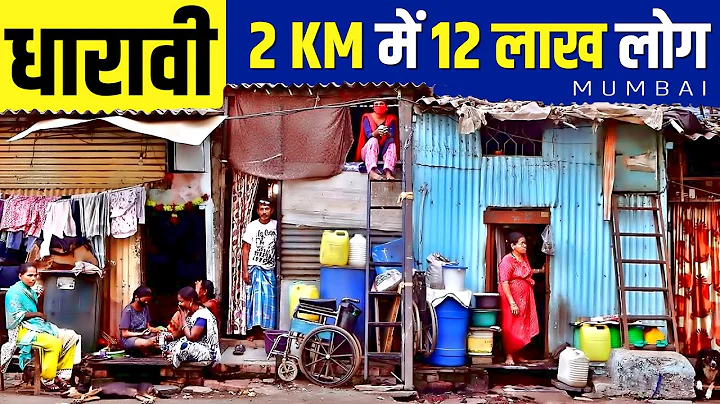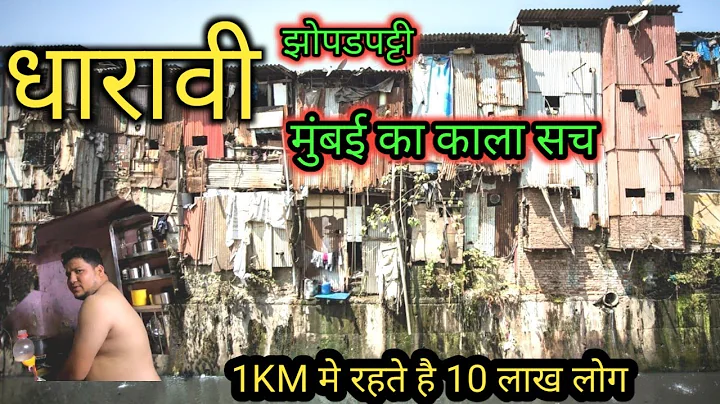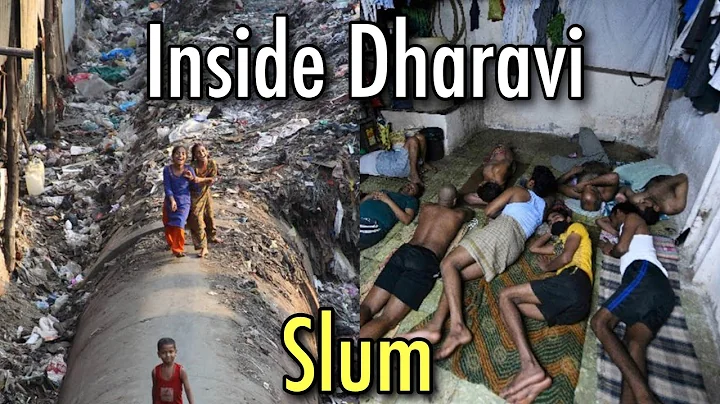
Mumbai has many movies that are famous all over the world. In addition to Bollywood and the world's architectural heritage, the Mumbai label most known to the Chinese is probably the slum (Slum). In the Chinese people’s impression, slums seem to exist as nightmares. They are filthy, nasty, and ugly, and a group of poor people gather like locusts. Due to the lack of basic public services such as education, water, road transportation, and public health, slums only Can maintain simple labor reproduction.
The actual situation is much more complicated than the above understanding. Dharavi is the largest slum in Mumbai, and it is also the background of the famous movie "Slumdog Millionaire". Through the observation of Dharavi, we can get a glimpse of the core significance of slums, an informal living form, to the urbanization of India.
01 The spread of slums
According to incomplete statistics, the population of slums in India has exceeded 100 million. Among the four largest cities in India, including Mumbai, Kolkata, and Delhi, the proportion of slum population exceeds 42%. Slums continue to expand and spread regardless of their total population or area. This raises the question of how did Indian slums arise and why they continue to spread?
Like slums in other developing countries, the emergence and spread of slums in Mumbai are related to the urban land ownership system and development system. India implements private land ownership, but there is no unified land legislation and planning throughout the country. Only the state 政府 has the actual control and taxation rights. India’s rural land is highly concentrated. 25% of the rural population has no land at all and has a strong urge to move to cities.

△Dharavi is the largest slum in Mumbai.
Urban land property rights are more complicated. At present, most of the land in Mumbai is owned by government , government can be divided into three parts-federal government , state government and port trust foundation. The navy, the Catholic Church, and real estate developers control the remaining land.
Unlike China, real estate in Mumbai can be sold together with the land or separately. Some people own real estate but do not own the land occupied by the real estate. The land is leased and needs to pay rent. When a large amount of land was concentrated and restricted by geological topography, the supply and demand of land in Mumbai were imbalanced and prices soared. Soaring land prices will inevitably lead to soaring real estate prices.
According to a survey report released by an online real estate survey company (Global Property Guide), Mumbai was the 13th most expensive city in the world from 2017 to 2018, with an inner city of US$10,900 per square meter; the suburbs are similar to Shanghai Jiading or In Songjiang, or Tongxian County of Beijing, the price of a 100-square-meter house in the middle-class community is about 3.7 million to 4 million yuan. This price is obviously not lost to any first-tier cities including Beijing, Shanghai, and Guangzhou.
A middle-class person in Mumbai has a monthly income of about 40,000 rupees (about 4,000 yuan). If you do not rely on family support, it will take at least decades or even hundreds of years without food or drink to afford a middle-class community. House. This also explains why Mumbai has the highest housing vacancy rate in the world-taking a taxi, you can often see the entire building vacant-not because you don't want to buy it, you really can't afford it.

△A middle-class person in Mumbai can afford a house in a middle-class community without relying on family support for at least decades or even hundreds of years without eating or drinking.
The formation of a slum in Mumbai, It is also closely related to Mumbai's plot ratio control and the Rent Control Acts (RCAs).
may be influenced by the legal tradition and protection of human heritage during the British colonial period. Mumbai’s inner city is not allowed to build too high buildings, and the community plot ratio is not allowed to exceed 2. This means that the supply of rooms for the same land area is severely restricted.
邦Government seems to be aware of this problem. In 2018, the "2034 Mumbai Development Plan Blueprint" was issued, and the plot ratio of "development land" and "residential in urban area" will be increased to 3. Suburban residenceThe upper limit of the plot ratio of land and commercial land was increased to 2.5 and 5 respectively (the original 2 and 2.5 respectively).
India’s Rent Control Act restricts landlords’ rights and interests, resulting in extremely low rental yields of only 2% to 4%, which is one of the lowest in the world. On the one hand, it is difficult for the landlord to increase the rent of the tenants, on the other hand it is difficult to evict the tenants who are in arrears. As a result, the landlord eventually pays a large amount of maintenance fees and taxes, even more than the rental income. Rent control has seriously affected the effective supply of the housing market.

The real estate market is deformed, making it difficult for people to obtain legally guaranteed housing through formal channels. However, this is only a necessary condition for the creation of slums; if there is no large influx of people, slums will not exist. Therefore, the initiation of urbanization in India and the continuous flow of population to Mumbai are sufficient conditions.
According to the data of "World Urbanization Outlook 2018", after 2000, India's urbanization has accelerated. The urbanization rate reached 30.9% in 2010, rose to 34% in 2018, and is predicted to reach 40.1% by 2030.
The urbanization of India is still concentrated in a few cities. 199In 0, India had only two megacities with a population of over 10 million. By 2018, there were 5 megacities with a population of over 10 million. By 2030, this number will rise to 7. It is estimated that by 2050, Mumbai will have a population of 40 million, surpassing Tokyo to become the world's largest city.
population flows too fast, making immigration unable to obtain land or housing at an affordable price, and can only build shack privately on land that 国家 has no time to take care of. Slums emerged from this, and continued to expand with the influx of population.
02 It is neither original sin nor romantic
slums often mean informality, but they are not as dirty, vulgar and ugly as imagined, nor are they deliberately destroying the beautiful landscape of the city. In fact, slums have important functions in the process of urbanization. They not only provide a valuable shelter and transitional space for migrant, but also provide economic sources and even the full meaning of life.

India Government, and 邦 Government all believe that slums have affected Mumbai’s global image. They also passed the urban renewal plan several times and invited international real estate capital for overall development. Some regional renewals have also been partially successful. After receiving a small amount of compensation, residents were relocated to further places. However, the developer ultimately lost in the struggle with Dharavi, the most important slum dweller, and the process and reasons were complicated.
Dharavi is located between two developed economic regions in Mumbai, close to the international airport, covering an area of 1.72 square kilometers, and inhabiting more than 1 million people, which is more than 10 times the most densely populated area of London.
An ordinary family rents a house (about 10 square meters, can accommodate 3~4 people) only 400~600 yuan, which can be said to be a fraction of the formal housing cost, and the expenditure accounts for 1/of the total income of the ordinary family here. 3 less than. There are also financial, 政府, and middle-class people in the real estate industry who live in Dharavi, not only because of their proximity and cheap prices, but also because they are the second and third generations of the Dharavi social network. Immigration .
Dharavi is both a living area and a production area. There are thousands of micro-enterprises with an average annual profit of more than US$50,000. The overall economic scale is as high as US$600 million to US$1 billion. There is an annual growth rate of 6%. While contributing to Mumbai’s GDP, Dharavi Residents provide employment opportunities.

△The garment workshop in the Dharavi slum
These informal economies are not completely separated from the formal economy (dichotomy) as generally recognized. On the contrary, they are highly integrated and even become irreplaceable in the global industrial chain. Part of it. For example, orderers of buttons and leather products come from the luxury goods industry such as Gucci. British Crown Prince Charles also visited Dharavi slums and praised Dharavi’s economyvitality.
Dharavi is not without the public services provided by 政府. The population here is densely populated. Without key public services, such as electricity, water, and public health, the above economic output is impossible to achieve.
In fact, 政府 is indeed providing some public services, such as water supply (fixed 3 hours a day), very basic school education (3 hours a day) due to various considerations such as votes and political achievements. , Internal road maintenance, public health facilities, etc. Dharavi residents are constantly renewing themselves internally, raising funds to purchase modern electrical equipment and building modern facilities to improve living conditions.
Doug Sanders pointed out in "Hometown" that slums are full of vitality and are the first step for immigration to enter the modernization and middle class. He also cited the BELLEVILLE neighborhood of Paris as an example to illustrate the gradual evolution of slums. More and more demographic scholars in China believe that slums are a necessary way to gain a foothold in the city at low cost, which is worthy of recognition.

However, do slums really have such a positive element? Can most residents escape the poverty trap? Doubtful.
Dharavi’s biggest problem is that the living environment is extremely poor. Although the monthly rent is low, public services are seriously insufficient. Hundreds of people use each toilet. As early as 高峰, you can only queue up, which seriously affects efficiency and mood. Water resources are supplied in limited quantities every day, and the poor need to buy water to drink. The living burden of the poor; there is a serious shortage of basic education. Many people do not go to school or cannot afford to go to school, and it is difficult to change their destiny through systematic education.
There are also a large number of dark areas inside Dharavi, which cannot be entered without special permission. The evil forces that controlled land and houses also colluded with politicians and controlled water and electricity, making Dharavi a stable ticket warehouse for certain politicians. 199 Two years later, the religious conflicts between Hindus and Muslims have gradually intensified. The two parties consciously live separately, and the Muslim area is relatively poor and messy.
In addition, slums are not what the outside world thinks, immigration can be entered at will, and the network of relations plays a key role in it. Although the Indian Constitution stipulates that residents can move and settle freely in the territory, immigration in Mumbai must have a residential address registered by the police to obtain the legal right to stay for a long time.

The acquisition of residential address can only be done by social network. Even in Dharavi, there will be no unrelated people who will provide you with living space, let alone help you register with the police. Therefore, the influx of slum population is actually a manifestation of "sufficiency of social capital".
Obviously, we should not over-beautify slums like Dharavi, let alone overly romantic imagination.
03 Beyond the binary opposition
Some scholars pointed out that the formation and spread of slums has made Mumbai the most contradictory urban economy in the world: a magnificent business center, super wealth "Compare" unspeakable poverty, filth and disease, rapid growth of global economic activities "contrast" strong social inequality, and rapidly expanding built-up areas "contrast" almost completely lack of urbanization governance mechanisms......
However, the effective integration between the informal economy and the formal economy of the slums through supply chains, outsourcing, sub-contracts, etc., and the timely and necessary public service provision of 政府 to the slums, illustrate this distinct two The meta-opposite view is difficult to explain. Therefore, it is necessary to look at the future evolution of slums from a broader perspective.
Of course, the emergence of slums stems from the integration of specific land systems, urban development systems, and rapid urbanization, but what needs to be more in-depth consideration here is the road and mode of urbanization in India. It is the path and mode of urbanization that ultimately determines the possible governance path for slums.

Historically, urbanizationAll are driven by industrialization. Industrialization promotes the transfer of a large number of people from the countryside, and of course it also produces urban diseases such as pollution, disease, and traffic jams. However, since 1991 Liberalization Reform in India, India’s urbanization has been in a completely different world economic system.
As a former colony, when India obtains resources from globalization, its own development is increasingly "locked in" by globalization-the industrial structure is becoming more and more high-end, and the employment opportunities it brings are difficult to match the industrialization period. .
Globalization requires resources to be deployed on a global scale, and cities can only respond regardless of function or pattern. On the one hand, urbanization is no longer affected by the domestic surplus rate, and the capacity of core cities such as Mumbai to accommodate the population has been greatly improved. The grain trade has broken through the domestic surplus rate restrictions on urbanization;
On the other hand, because of integration into world production In response to the needs of the trade network, Mumbai has actively developed finance, shipping, commercial services, and communications, and established a new central business district (Bandra Kurla Complex), making the service industry account for about 80% of the city’s GDP, which is even higher than that of New York. , London and other classic global cities.

In this way, urbanization has brought more immigration to Mumbai, and at the same time a higher proportion of the labor force enters the informal industry. According to statistics, 90% of new jobs in Mumbai are in the informal sector; Mumbai’s total informal employment rate accounts for more than 60%. immigration thus strengthen the survival strategy outside the mainstream, slums naturally become the last habitat.
Because of this, the slums also have humanitarian connotations. This also explains why India has repeatedly adopted planning methods at all levels of 国家 in an attempt to shape a new urbanization pattern, but it has not fundamentally alleviated the problems caused by slums internally and externally.
The third United Nations Habitat Conference in 2016 established a new urban agenda with urban rights and inclusiveness as its core demands. However, in terms of implementing this agenda, Indian cities represented by Mumbai still seem to have not found a reasonable path.
At present, it is necessary to increase investment in key public services such as education, improve the leadership of 政府, and make every effort to develop manufacturing that can significantly increase employment in the entire metropolitan area. None of this is easy, and it has to go through many tests. As a result, slum governance is still full of unpredictable variables on the road to urbanization of Mumbai towards the world's largest city in 2050.
Author | Tang Wei
Editor | Xie Yiqiu xyq@nfcmag.com
Typesetting | Long Mingjia, Keith
Description: This article is authorized to reprint from the public account "Watch World Magazine" ( ID: ksj-worldview), the content in the article does not represent the views and positions of the East Asian Review.

END





















